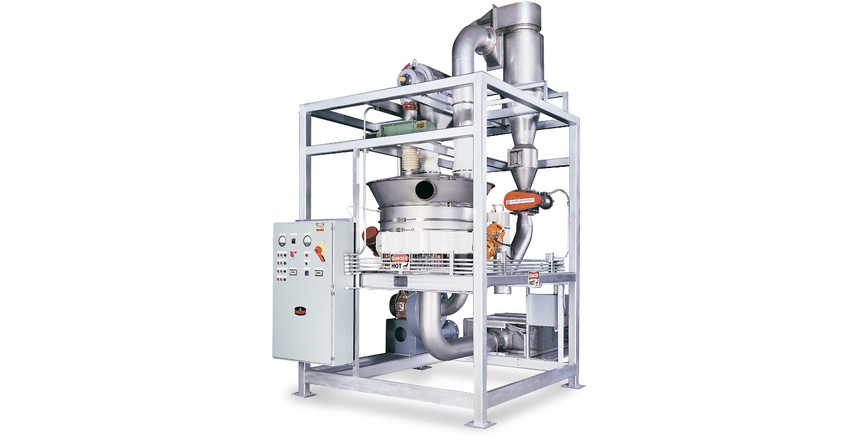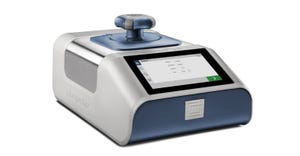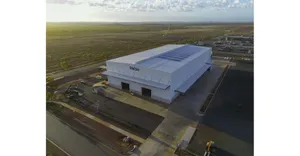Circular Versus Rectangular Fluid Bed Dryers and Coolers
When sourcing a vibratory fluid bed dryer or cooler, a circular model should be considered for multiple reasons.
July 10, 2020

Sunny Nwadinma, senior applications engineer, Kason Corp.
Vibratory fluid bed dryers and coolers have become popular for many applications due to rapid drying times and suitability for heat-sensitive products. Fluid bed dryers/coolers offer batch and continuous processing capabilities, enabling high throughput for drying and heating applications.
In surveying the different types of vibratory fluid bed dryers and coolers, a number of features make circular models the ideal choice over their rectangular counterparts, including:
1. Air flows in a circular pattern. In a rectangular fluid bed there are dead spaces in the corners. In a circular fluid bed the air velocity is uniform, which results in consistent heating and product moistures.
2. The center feed allows for continuous internal back mixing for blending the wet feed with a deep bed of semi-dry product. This gives a wider window of operation for handling sluggish/hard to fluidize materials.
3. The capability of a deeper bed translates to a smaller footprint per volume processed.
4. Option for air directional plates for quicker cleanout and tangential air flow to minimize carryover
5. The air-lift design allows easier, faster access for cleaning and inspection.
6. Compliance with stringent 3A, USDA, FDA, and BISCC sanitary standards
7. A bag-top (dust collector mounted directly on top of the fluid bed) unit is designed to handle fine powders without short circuiting to a remote dust collector.
8. Lower installation and operational costs
9. The circular design is stronger, improving structural integrity.
10. Dual-deck design with separate air flows doubles the evaporation capacity of single deck unit.
Benefits of Circular Design
Selection and Performance
Circular vibratory fluid bed dryers and coolers are available in a range of sizes, from 18 to 84 in. in diam. This offers manufacturers a range of flexibility for both small batches and large continuous throughput applications. Materials processed in a circular vibratory fluid bed move in a spiral motion, creating even airflow and vibration throughout the bed to separate and fluidize individual particles. The spiral motion maximizes material surface area and drying, yielding a highly consistent product.
By virtue of design, circular vibratory fluid beds are free of any internal corners or edges, eliminating those hard-to-clean areas where material could potentially accumulate over time. Additionally, a circular configuration allows for precise control of air temperature, air flow, bed depth, dwell time, and material flow paths on a first-in/first-out basis. The circular design also offers built-in internal back-mixing of product so that wetter, sloppier feed materials are dried more consistently and with a lower heat history. This renders a more homogenous material while also keeping the machine cleaner and easier to maintain in the long term.
Inherent strength is another benefit of the circular vibratory fluid bed processor: its design eliminates the need for heavy-gauge walls and cross braces that are otherwise required to withstand continuous vibration. This means that materials of construction can be down-gauged, vibratory motors can be downsized, and associated components can be eliminated. Circular units also only require one air inlet and outlet and will have fewer weld seams compared to rectangular models, reducing overall size and construction costs—especially when finished to 3-A, USDA, FDA, BISCC, and other such stringent sanitary standards.
Efficiency and Savings
Circular vibratory fluid bed dryers offer significant cost savings: lower installation costs and multi-purposing are just the start. Energy savings is also significant for circular fluid beds, which consume 40 to 50% less power on average than rectangular models for the same throughput and moisture content. Additional cost savings are found in the deeper beds for circular models, which can increase throughput per square foot of factory space and increase overall efficiency for facilities.
Overall costs and downtime expenses can also be reduced through faster and easier sanitation. Cleaning for circular dryers/coolers can be completed thoroughly in under an hour, whereas rectangular dryers/coolers can take several hours to clean. This ability to quickly sanitize the equipment makes a huge difference for food and pharmaceutical applications in terms of cost, consumer safety and quality assurance.
Safety and Accommodation
Explosion-proof design is another important feature for production-line safety. The circular fluid bed allows higher pressure design to minimize the amount of explosion protection required. Although not available for every circular fluid bed dryer or cooler, if an application involves any volatile or dangerous materials, be sure to confirm the explosion-proofing level of machinery with its manufacturer prior to purchasing to ensure you make the best selection.
Additionally, circular vibratory bed dryers and coolers are much quieter to operate because of vibration reduction mechanisms well within OSHA requirements. While the blowers make some noise, it is typically only up to 85 decibels.
Rectangular fluid bed dryers/coolers require extensive rigging to stabilize the machines because of the high-intensity vibrations. In contrast, most circular vibratory fluid bed dryers/coolers are equipped with internal vibration cancellation technologies and do not need to be mounted to walls and floors to remain stable in place.
Finally, circular units do not require the complex installation process that their rectangular counterparts do. Because of their configuration, entire fluid bed systems (including heaters/coolers/moisturizers, blowers, and dust collectors) can be self-contained and skid-mounted on common frames with casters, ready to plug in and run (plug-and-go). This offers fast setup, compactness, mobility, and flexibility—features that cannot be accomplished through rectangular units that are two to three times larger and heavier at equivalent capacities.
When to Choose a Rectangular Design
Rectangular vibratory fluid bed dryers/coolers are generally suitable for high-capacity applications or if you have plenty of floor space available or if you are handling only one product and do not required to clean often, the rectangular fluid bed is a viable option. Most rectangular fluid bed dryer and cooler units can be configured to any size, and large conveyors can provide very high throughput for fluid beds. If you have a very high-throughput application and ample floor space for a fluid bed dryer/cooler, then a rectangular model might be the right choice. Cleaning rectangular units also requires a certain degree of expertise, as maintenance staff must open and dismantle covers and get into the dryers/coolers to thoroughly clean them. If your production line has shifts that can accommodate a more extensive sanitization routine, or if there are no major sanitary requirements to take into consideration for your specific application, then a rectangular unit may be appropriate. However, if you can accomplish the same throughput needed with an easier-to-clean circular dryer/cooler, then adopting a circular configuration can provide long-term savings on overhead expenses related to the routine maintenance of your unit.
Conclusion
When sourcing a vibratory fluid bed dryer or cooler, a circular model should be considered for its consistent and efficient drying results, quick-clean sanitary design, smaller footprint, lower initial and operating costs, and reduced downtime. Rectangular options are appropriate in high-volume continuous applications where there is plenty of floor space and the need for pristine sanitation is not highly prioritized. Today’s circular vibratory fluid bed dryers/coolers are available from small-batch, pilot plant/lab sizes to larger models suitable for continuous processing applications, offering a wide range of options suitable for most applications.
Sunny Nwadinma is the senior applications engineer at Kason Corp. He covers product lines of circular fluidized-bed dryers, coolers and moisturizers, circular vibratory and centrifugal sifters, and static sieve screeners. Kason is a leading manufacturer of screening equipment and circular fluid bed dryers, coolers, and moisturizers for powder and bulk solids ranging from dry or moist materials to solids-laden slurries. Screening applications include classifying, sifting, scalping, de-dusting, and dewatering on a batch or continuous basis. For more information, visit kason.com.
You May Also Like


